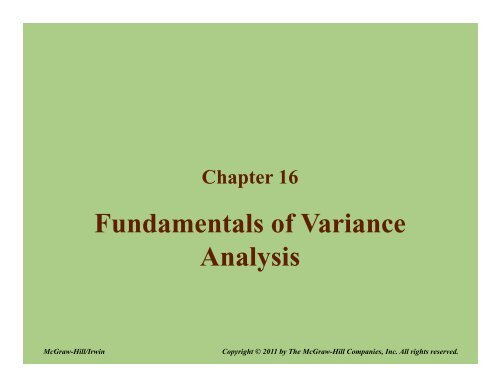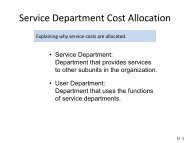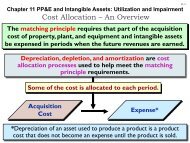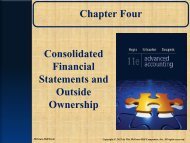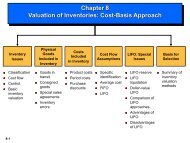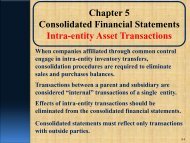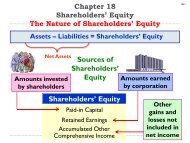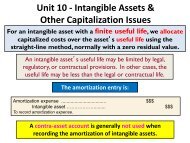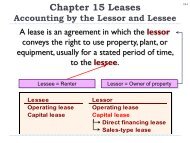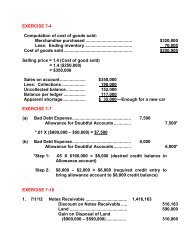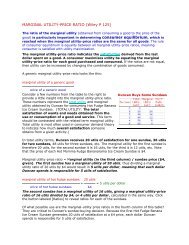Fundamentals of Variance Analysis - Anna Lee
Fundamentals of Variance Analysis - Anna Lee
Fundamentals of Variance Analysis - Anna Lee
Create successful ePaper yourself
Turn your PDF publications into a flip-book with our unique Google optimized e-Paper software.
Chapter 16<strong>Fundamentals</strong> <strong>of</strong> <strong>Variance</strong><strong>Analysis</strong>McGraw-Hill/IrwinCopyright © 2011 by The McGraw-Hill Companies, Inc. All rights reserved.
LO1Pr<strong>of</strong>it <strong>Variance</strong>• Favorable variance:<strong>Variance</strong> that, taken alone, increases operating pr<strong>of</strong>it• Unfavorable variance:<strong>Variance</strong> that, taken alone, reduces operating pr<strong>of</strong>it16-3
LO1Pr<strong>of</strong>it <strong>Variance</strong>Sales (units)Sales revenueLess: Variable costsVariable mfg. costsVariable selling and administrativeTotal variable costsContribution marginFixed costs:Fixed manufacturing overheadFixed selling and administrative costsTotal fixed costsPr<strong>of</strong>itBayou DivisionBudget and Actual ResultsAugust (p 585)a$10.00 per unit b$3.80 per unit c$0.90 per unitActual80,000$840,000329,68068,000$397,680$442,320195,500132,320$327,820$114,500<strong>Variance</strong>MasterBudget100,000 a$1,000,000380,000 b90,000 c$ 470,000$ 530,000200,000140,000$ 340,000$ 190,00016-4
LO1Pr<strong>of</strong>it <strong>Variance</strong>Sales (units)Sales revenueLess: Variable costsVariable mfg. costsVariable selling and administrativeTotal variable costsContribution marginFixed costs:Fixed manufacturing overheadFixed selling and administrative costsTotal fixed costsPr<strong>of</strong>itBayou DivisionBudget and Actual ResultsAugusta$10.00 per unit b$3.80 per unit c$0.90 per unitActual80,000$840,000329,68068,000$397,680$442,320195,500132,320$327,820$114,500<strong>Variance</strong>20,000 U$160,000 U50,320 F22,000 F$ 72,320 F$ 87,680 U4,500 F7,680 F$ 12,180 F$ 75,500 UMasterBudget100,000 a$1,000,000380,000 b90,000 c$ 470,000$ 530,000200,000140,000$ 340,000$ 190,00016-5
Flexible BudgetingL.O. 2Develop and use flexible budgets.• Static budget:Budget for a single activity level;usually the master budget• Flexible budget:Budget that indicates revenues, costs,and pr<strong>of</strong>its for different levels <strong>of</strong> activity16-6
Sales Activity <strong>Variance</strong>L.O. 3Compute and interpret the sales activity variance.• Sales activity variance:The difference between operating pr<strong>of</strong>itin the master budget and operating pr<strong>of</strong>itin the flexible budget that arises becausethe actual number <strong>of</strong> units sold is differentfrom the budgeted number16-7
LO3Sales Activity <strong>Variance</strong>Sales (units)Sales revenue (@ $10.00 per unit)Less: Variable costsVariable mfg. costs (@ $3.80 per unit)Variable selling and admin. (@ $0.90 per unit)Total variable costsContribution marginFixed costs:Fixed manufacturing overheadFixed selling and administrative costsTotal fixed costsPr<strong>of</strong>itBayou DivisionFlexible and Master BudgetAugust (p 587)FlexibleBudget80,000$800,000304,00072,000$376,000$424,000200,000140,000$340,000$ 84,000Sales-Activity<strong>Variance</strong>20,000 U$200,000 U76,000 F18,000 F$ 94,000 F$106,000 U-0--0--0-$106,000 UMasterBudget100,000$1,000,000380,00090,000$ 470,000$ 530,000200,000140,000$ 340,000$ 190,00016-8
Pr<strong>of</strong>it <strong>Variance</strong> <strong>Analysis</strong>L.O. 4Prepare and use a pr<strong>of</strong>it variance analysis.• Pr<strong>of</strong>it variance analysis:<strong>Analysis</strong> <strong>of</strong> the causes <strong>of</strong> differences betweenbudgeted pr<strong>of</strong>its and the actual pr<strong>of</strong>its earnedSales price varianceVariable production cost variancesFixed production cost variancesMarketing and administrative cost variances16-9
LO4Pr<strong>of</strong>it <strong>Variance</strong> <strong>Analysis</strong>Bayou DivisionPr<strong>of</strong>it <strong>Variance</strong> <strong>Analysis</strong>August (p 589)ActualMfg.<strong>Variance</strong>sMarketingand Admin.<strong>Variance</strong>sSalesPrice<strong>Variance</strong>FlexibleBudgetSalesActivity<strong>Variance</strong>MasterBudgetSales (units)Sales revenueLess: Variable costsVariable manufacturing costs aVariable selling and administrativeContribution marginFixed costs:Fixed manufacturing overheadFixed selling and administrative costsPr<strong>of</strong>it80,000$840,000329,68068,000$442,320195,500132,320$114,500$25,680 U$25.680 U4,500 F$21,180 U$ 4,000 F$ 4,000 F7,680 F$11,680 F$40,000 F$40,000 F$40,000 F80,000$800,000304,00072,000$424,000200,000140,000$ 84,000$200,000 U76,000 F18,000 F$106,000 U-0--0-$106,000 U100,000$1,000,000380,00090,000$ 530,000200,000140,000$ 190,000Total variance from flexiblebudget = $30,500 FTotal variance from master budget = $75,500 UaThe $25,680 manufacturing variance is explained in detail in L.O. 5.16-10
LO4Sales Price <strong>Variance</strong>• Sales price variance:Difference between the actual selling priceand budgeted selling price multiplied bythe actual number <strong>of</strong> units sold($10.50 - $10) x 80,000 units = $40,000 F16-11
LO4Variable Production Costs• Standard cost sheet:A form providing the standard quantities <strong>of</strong>each input required to produce a unit <strong>of</strong>output and the standard price for each input.Bayou DivisionStandard Cost Sheet – Variable Manufacturing CostsAugustDirect materialDirect laborVariable overheadTotal variable manufacturing costsStandardQuantity <strong>of</strong> Inputper Unit <strong>of</strong> Output4 pounds0.05 hours0.05 hoursStandard InputPrice or Rateper Unit <strong>of</strong> Input$0.55 per pound$20 per hour$12 per hourStandard Costper Unit <strong>of</strong>Output (frame)$2.201.000.60$3.8016-12
Variable Cost <strong>Variance</strong> <strong>Analysis</strong>L.O. 5Compute and use variable cost variances.(1)ActualActual input price (AP)times actual quantity(AQ) <strong>of</strong> input(AP × AQ)(2)Actual Inputs atStandard PricesStandard input price (SP)times actual quantity(AQ) <strong>of</strong> input(SP × AQ)(3)Flexible ProductionBudgetStandard input price (SP)times standard quantity(SQ) <strong>of</strong> input allowed foractual good output(SP × SQ)Price variance(1) – (2)Efficiency variance(2) – (3)Total variance(1) – (3)16-13
LO5Production Cost <strong>Variance</strong>• Price variance:Difference between actual price and budgeted price• Multiply this difference by the actual quantity purchased.Price variance= (AP × AQ) – (SP × AQ)= AQ(AP – SP)16-14
LO5Production Efficiency <strong>Variance</strong>• Efficiency variance:Difference between the actual quantity used and thebudgeted quantity for the actual level <strong>of</strong> activity.• Multiply this difference by the budgeted price per unit.Efficiency variance = (SP × AQ) – (SP × SQ)= SP(AQ – SQ)16-15
LO5Direct Materials <strong>Variance</strong> (p 593)(1)ActualActual materials price(AP = $0.60)× Actual quantity(AQ = 328,000 pounds)<strong>of</strong> direct materials(2)Actual Inputs atStandard PricesStandard materials price(SP = $0.55)× Actual quantity(AQ = 328,000 pounds)<strong>of</strong> direct materials(3)Flexible ProductionBudgetStandard materials price(SP = $0.55)× Standard quantity(SQ = 320,000 pounds)<strong>of</strong> direct materialsallowed for actual outputAP × AQ = $196,800 SP × AQ = $180,400 SP × SQ = $176,000Price variance$196,800 – $180,400= $16,400 UEfficiency variance$180,400 – $176,000= $4,400 UTotal variance= $16,400 + $4,400 = $20,800 U320,000 = 4 #s x 80,000 frames (p 593)16-16
LO5Direct Labor <strong>Variance</strong> (p 596)(1)ActualActual labor price(AP = $18)× Actual quantity(AQ = 4,400 hours)<strong>of</strong> direct labor(2)Actual Inputs atStandard PricesStandard labor price(SP = $20)× Actual quantity(AQ = 4,400 hours)<strong>of</strong> direct labor(3)Flexible ProductionBudgetStandard labor price(SP = $20)× Standard quantity(SQ = 4,000 hours)<strong>of</strong> direct laborallowed for actual outputAP × AQ = $79,200 SP × AQ = $88,000 SP × SQ = $80,000Price variance$79,200 – $88,000= $8,800 FEfficiency variance$88,000 – $80,000= $8,000 UTotal variance= $8,800 – $8,000 = $800 F16-17
LO5Variable Overhead <strong>Variance</strong> (p 597)(1)ActualSum <strong>of</strong> actualvariablemanufacturingoverhead costs(2)Actual Inputs atStandard PricesStandard variableoverhead price(SP = $12)× Actual quantity(AQ = 4,400 hours)<strong>of</strong> the overhead base(3)Flexible ProductionBudgetStandard variableoverhead price (SP = $12)× Standard quantity(SQ = 4,000 hours)<strong>of</strong> the overhead base allowedfor actual output producedAP × AQ = $53,680(AP = 12.2 = 53,680/4,400)SP × AQ = $52,800 SP × SQ = $48,000Price variance$53,680– $52,800= $880 UEfficiency variance$52,800– $48,000= $4,800 UTotal variance= $880 + $4,800 = $5,680 U16-18
LO5Variable Manufacturing Cost<strong>Variance</strong> SummaryDirect materialsDirect laborVariable overheadTotal variable manufacturingcost variancePrice Efficiency Total$16,400 U$ 8,800 F$ 880 U$4,400 U$8,000 U$4,800 U$20,800 U$ 800 F$ 5,680 U$25,680 U16-19
Fixed Manufacturing OVH <strong>Variance</strong>s (p 600)(assuming fixed manufacturing OVH are treated as period costs)L.O. 6Compute and use fixed cost variances.• Spending (or budget) variance only;due to Price <strong>Variance</strong>• It is the difference between budgetedand actual fixed overhead• No Efficiency <strong>Variance</strong>• $195,500 actual – $200,000 budget = $4,500 F16-20
Fixed Manufacturing OVH <strong>Variance</strong>sLO6(assuming fixed manufacturing OVH are treated as product costs)• Use pre-determined standard cost rate;= Budgeted fixed manufacturing cost / Budgeted activity level•The difference between budgeted andapplied fixed overhead• <strong>Variance</strong> that arises because the volumeused to apply fixed overhead differs fromthe estimated volume used to estimatefixed cost per unit.$200,000 budget – $160,000 ($2x80,000 actual units) applied = $40,000 U$200,000 budget ÷ 100,000 budgeted units = $2 per unit80,000 units × $2 per unit = $160,000 applied16-21
Appendix: Recording Costsin a Standard Cost SystemL.O. 7(Appendix) Understand how to recordcosts in a standard costing system.• Work-in-process inventory is debited when directmaterials and direct labor are used at standard.• Work-in-process inventory is debited whenmanufacturing overhead is applied at standard.• When the units are finished, work-in-processinventory is credited and finished goodsinventory is debited.• <strong>Variance</strong>s are usually closed (write-<strong>of</strong>f) to cost <strong>of</strong> goods sold,Cost <strong>of</strong> Goods SoldManufacturing OVH AllocatedManufacturing OVH Control16-22


